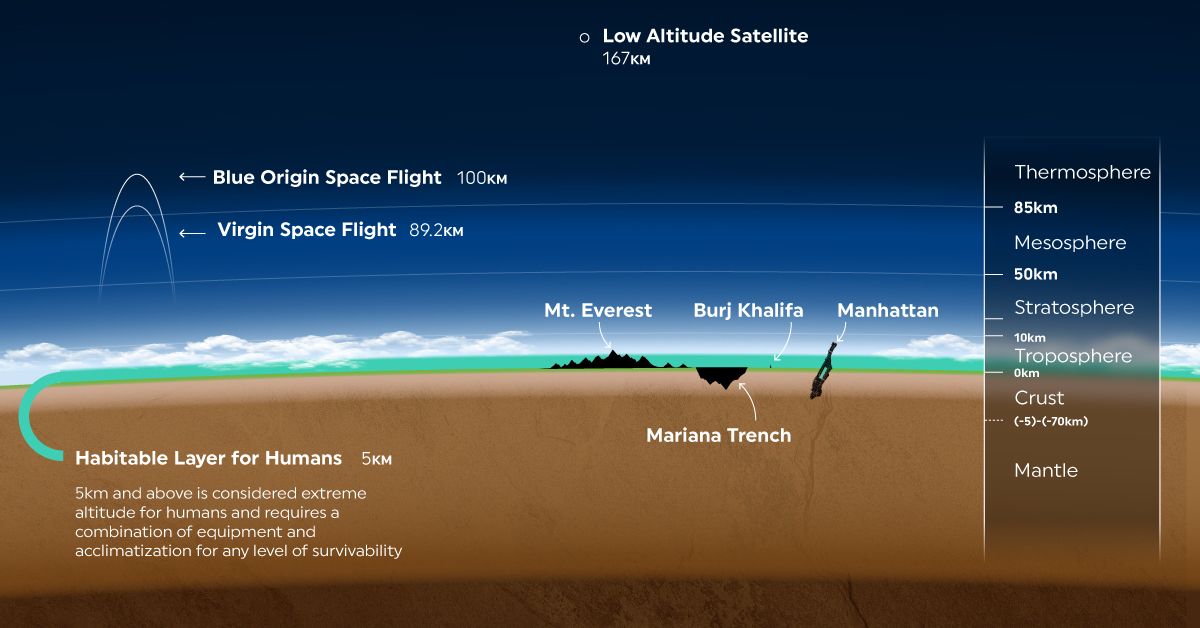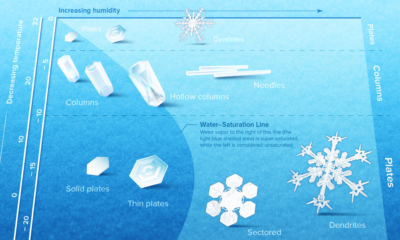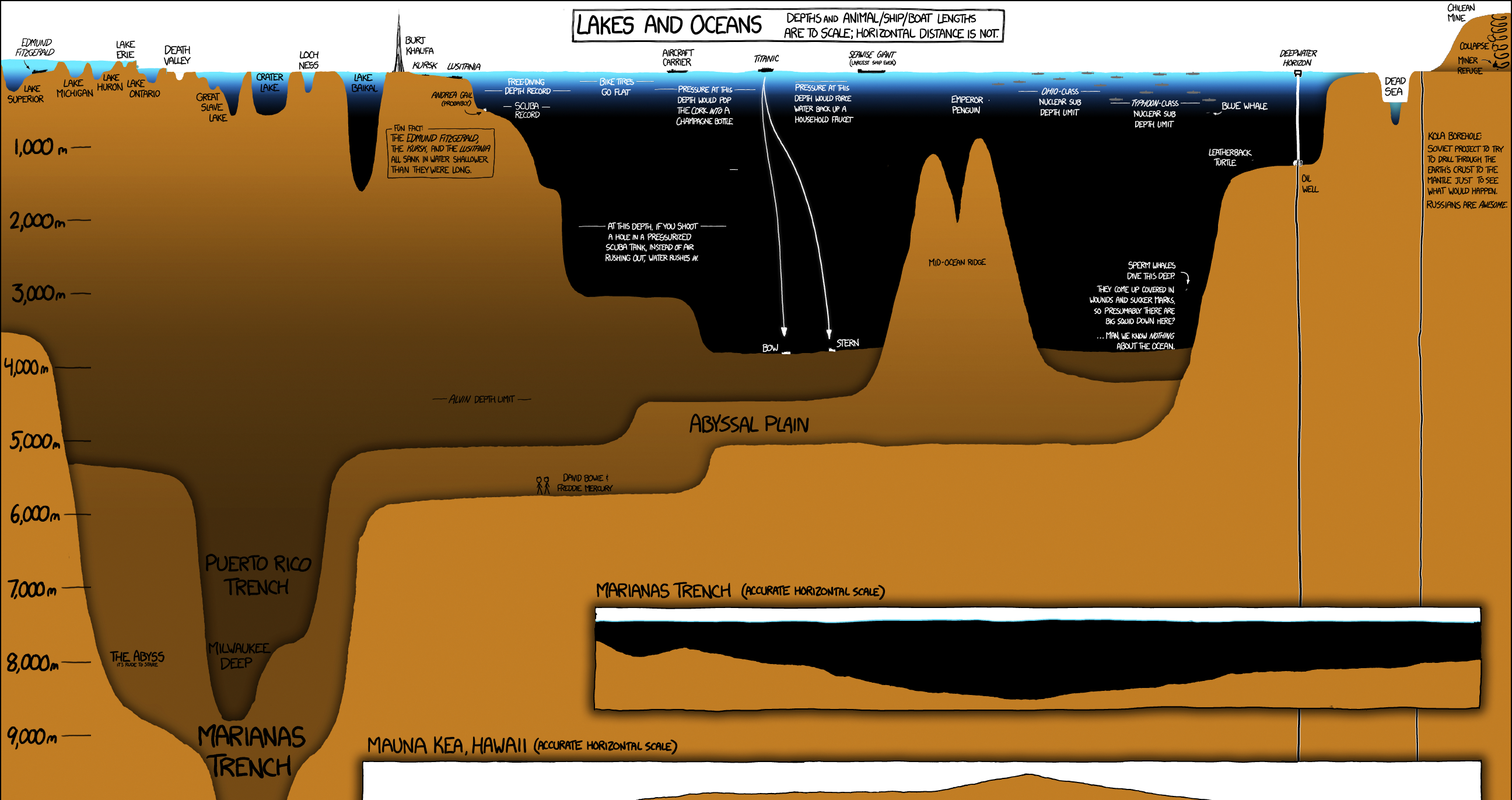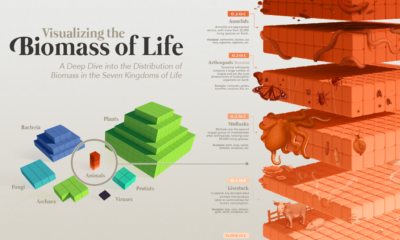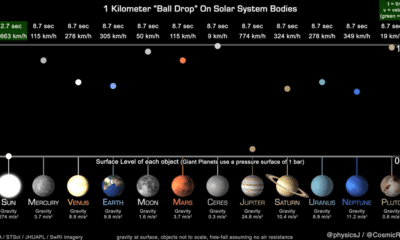Misc
Razor Thin: A New Perspective on Earth’s Atmosphere
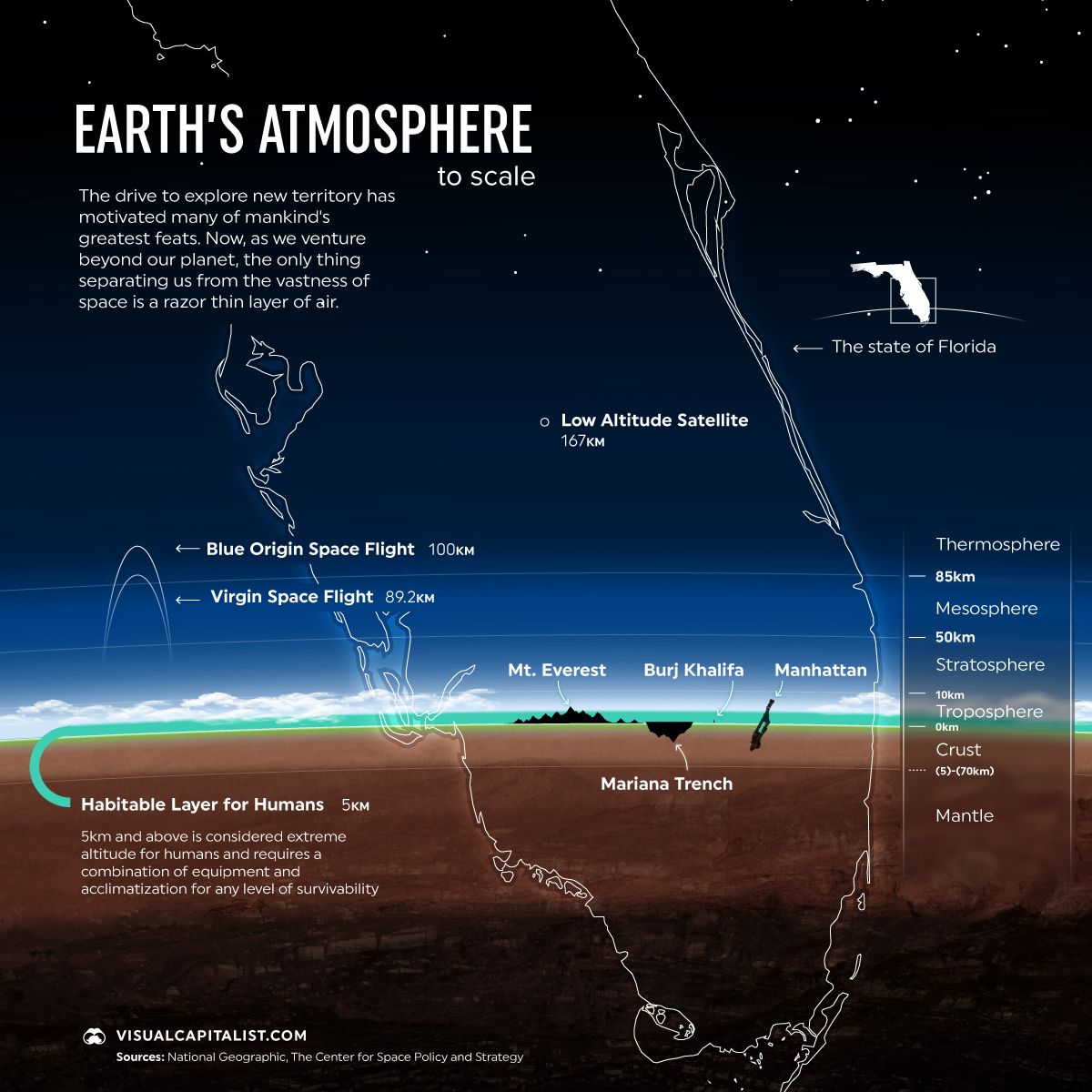
Razor Thin: A New Perspective on Earth’s Atmosphere
Earth is the only known planet that sustains life. Its atmosphere provides us with oxygen, protects us from the Sun’s radiation, and creates the barometric pressure needed so water stays liquid on our planet.
But while Earth’s atmosphere stretches for about 10,000 km (6,200 miles) above the planet’s surface, only a thin layer is actually habitable.
This graphic, inspired by Andrew Winter, shows just how small Earth’s “habitable zone” is, using the state of Florida as a point of reference.
Earth’s Like an Onion: It Has Layers
Our planet’s atmosphere is made up of a unique cocktail of gases—roughly 78% nitrogen and 21% oxygen, with trace amounts of water, argon, carbon dioxide, and other gases.
It’s separated into five different layers:
- Exosphere: The uppermost layer of our atmosphere that melds into outer space.
- Thermosphere: Begins at around 80 km (50 miles) above sea level and extends to approximately 600 km (372 miles), reaching temperatures as high as 2,000°C (3,600°F).
- Mesosphere: Around 30 km (19 miles) in range, meteors burn as they pass through this layer, creating “shooting stars.”
- Stratosphere: Home to the ozone layer, which is responsible for absorbing a majority of the sun’s radiation.
- Troposphere: The closest layer to ground. It stretches about 7–15 kilometers (5–10 miles) from the surface.
The troposphere makes up approximately 75-80% of the atmosphere’s mass, as it’s where most of the dust, ash, and water vapor are stored. But only a part of this layer is suitable for human life—in fact, the atmosphere’s habitable zone is so small, several mountain ranges extend beyond it.
Reaching Into Earth’s Atmosphere: Extremely High Altitudes
Elevations above 5,500 meters (18,000 ft) are considered extremely high altitude and require special equipment and/or acclimatization in order to survive. Even then, those who choose to venture to extreme heights run the risk of getting altitude sickness.
When it comes to the world’s tallest mountain ranges, the Himalayas are the highest. At their peak, Mount Everest, the Himalayas reach 8,848 m (29,000 ft) above sea level.
| Mountain range | Highest mountain | Height | Countries |
|---|---|---|---|
| Himalayas | Mount Everest | 8,848 m | Nepal, China |
| Karakoram | K2 | 8,611 m | Pakistan |
| Hindu Kush | Tirich Mir | 7,708 m | Pakistan |
| Kongur Shan | Kongur Tagh | 7,649 m | China |
| Daxue Mountains | Mount Gongga | 7,556 m | China |
| Pamir Mountains | Ismoil Somoni Peak | 7,495 m | Tajikistan |
| Kakshaal Too | Jengish Chokusu | 7,439 m | China, Kyrgyzstan |
| Nyenchen Tanglha Mountains | Gyala Peri | 7,294 m | China |
| Andes | Aconcagua | 6,960 m | Argentina |
| Kunlun Mountains | Chakragil | 6,760 m | China |
| Cordillera de la Ramada | Mercedario | 6,720 m | Argentina |
| Tian Shan | Xuelian Feng | 6,627 m | China |
| Hindu Raj | Buni Zom | 6,542 m | Pakistan |
| Cordillera Occidental | Chimborazo | 6,263 m | Ecuador |
| Alaska Range | Denali | 6,191 m | USA |
| Saint Elias Mountains | Mount Logan | 5,959 m | Canada |
| Eastern Rift mountains | Mount Kilimanjaro | 5,895 m | Tanzania |
| Sierra Nevada de Santa Marta | Pico Cristóbal Colón | 5,700 m | Colombia |
| Caucasus Mountains | Mount Elbrus | 5,642 m | Russia |
| Trans-Mexican Volcanic Belt | Pico de Orizaba | 5,636 m | Mexico |
| Alborz | Mount Damavand | 5,610 m | Iran |
| Yun Range | Jade Dragon Snow Mountain | 5,596 m | China |
| Bogda Shan | Bogda Peak | 5,445 m | China |
| Cordillera Oriental | Ritacuba Blanco | 5,410 m | Colombia |
| Armenian Highlands | Mount Ararat | 5,137 m | Turkey |
| Rwenzori Mountains | Mount Stanley | 5,109 m | Congo, Uganda |
Despite the dangers of extreme altitude, hundreds of mountaineers attempt to climb Mount Everest each year. On Everest, the region above 8,000 m (26,000 feet) is referred to as the “death zone,” and climbers have to bring bottled oxygen on their trek in order to survive.
Life Beyond Earth
Earth is the only known planet with an atmosphere we can survive in. And even on Earth, certain areas are considered dead zones.
But there may be other life forms out in the galaxy that we haven’t discovered. Recent research in The Astrophysical Journal predicts there are at least 36 intelligent civilizations throughout the galaxy today.
So life may very well exist beyond Earth. It just might look a bit different than we’re used to.
Misc
How Hard Is It to Get Into an Ivy League School?
We detail the admission rates and average annual cost for Ivy League schools, as well as the median SAT scores required to be accepted.

How Hard Is It to Get Into an Ivy League School?
This was originally posted on our Voronoi app. Download the app for free on iOS or Android and discover incredible data-driven charts from a variety of trusted sources.
Ivy League institutions are renowned worldwide for their academic excellence and long-standing traditions. But how hard is it to get into one of the top universities in the U.S.?
In this graphic, we detail the admission rates and average annual cost for Ivy League schools, as well as the median SAT scores required to be accepted. The data comes from the National Center for Education Statistics and was compiled by 24/7 Wall St.
Note that “average annual cost” represents the net price a student pays after subtracting the average value of grants and/or scholarships received.
Harvard is the Most Selective
The SAT is a standardized test commonly used for college admissions in the United States. It’s taken by high school juniors and seniors to assess their readiness for college-level academic work.
When comparing SAT scores, Harvard and Dartmouth are among the most challenging universities to gain admission to. The median SAT scores for their students are 760 for reading and writing and 790 for math. Still, Harvard has half the admission rate (3.2%) compared to Dartmouth (6.4%).
| School | Admission rate (%) | SAT Score: Reading & Writing | SAT Score: Math | Avg Annual Cost* |
|---|---|---|---|---|
| Harvard University | 3.2 | 760 | 790 | $13,259 |
| Columbia University | 3.9 | 750 | 780 | $12,836 |
| Yale University | 4.6 | 760 | 780 | $16,341 |
| Brown University | 5.1 | 760 | 780 | $26,308 |
| Princeton University | 5.7 | 760 | 780 | $11,080 |
| Dartmouth College | 6.4 | 760 | 790 | $33,023 |
| University of Pennsylvania | 6.5 | 750 | 790 | $14,851 |
| Cornell University | 7.5 | 750 | 780 | $29,011 |
*Costs after receiving federal financial aid.
Additionally, Dartmouth has the highest average annual cost at $33,000. Princeton has the lowest at $11,100.
While student debt has surged in the United States in recent years, hitting $1.73 trillion in 2023, the worth of obtaining a degree from any of the schools listed surpasses mere academics. This is evidenced by the substantial incomes earned by former students.
Harvard grads, for example, have the highest average starting salary in the country, at $91,700.
-

 Maps2 weeks ago
Maps2 weeks agoMapped: Average Wages Across Europe
-

 Money1 week ago
Money1 week agoWhich States Have the Highest Minimum Wage in America?
-

 Real Estate1 week ago
Real Estate1 week agoRanked: The Most Valuable Housing Markets in America
-

 Markets1 week ago
Markets1 week agoCharted: Big Four Market Share by S&P 500 Audits
-

 AI1 week ago
AI1 week agoThe Stock Performance of U.S. Chipmakers So Far in 2024
-

 Automotive1 week ago
Automotive1 week agoAlmost Every EV Stock is Down After Q1 2024
-

 Money2 weeks ago
Money2 weeks agoWhere Does One U.S. Tax Dollar Go?
-

 Green2 weeks ago
Green2 weeks agoRanked: Top Countries by Total Forest Loss Since 2001




